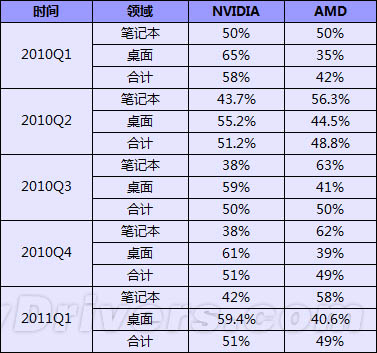 Graphics card makers cited the latest data from market research agency Mercury Research, claiming that in the first quarter of 2011, NVIDIA and AMD will continue to compete fiercely in the graphics card market, and each has its own advantages, but the overall gap is small.
Graphics card makers cited the latest data from market research agency Mercury Research, claiming that in the first quarter of 2011, NVIDIA and AMD will continue to compete fiercely in the graphics card market, and each has its own advantages, but the overall gap is small.
In the first three months of this year, NVIDIA achieved a 42% share of the notebook graphics card market. Although it still lags behind, it has risen by 4 percentage points compared to the previous quarter. On the desktop market, NVIDIA lost a 0.6% share after a slight rebound at the end of last year, but it still has 59.4%, and AMD is naturally 40.6%.
The overall share still accounted for 51% and 49% respectively, which was the same as last quarter.
In the first quarter of 2011, NVIDIA and AMD were equally divided in the notebook market, with NVIDIA taking a 65% lead in the desktop market, with an overall share of 58%.
As the platform competition from Intel and AMD is fierce, NVIDIA has gradually withdrawn from the chipset market and has directly affected the market performance of its integrated graphics. Due to NVIDIA's lack of comprehensive x86 processor and chipset licensing, the market share of notebook graphics cards has been declining throughout the year. Despite efforts to regain one city early this year, it is unlikely that they want to surpass AMD again.
The Fermi architecture desktop graphics card is the main driving force for NVIDIA's market share. The strategy of vigorously promoting CUDA, surface subdivision, and OpenCL 1.1 technologies is also the key to determining whether NVIDIA can maintain its share.
According to Jon Peddie Research (JPR)'s previously published report, Intel and AMD in the overall graphics market in the first quarter of 2011 have made significant progress and have squeezed NVIDIA's living space.